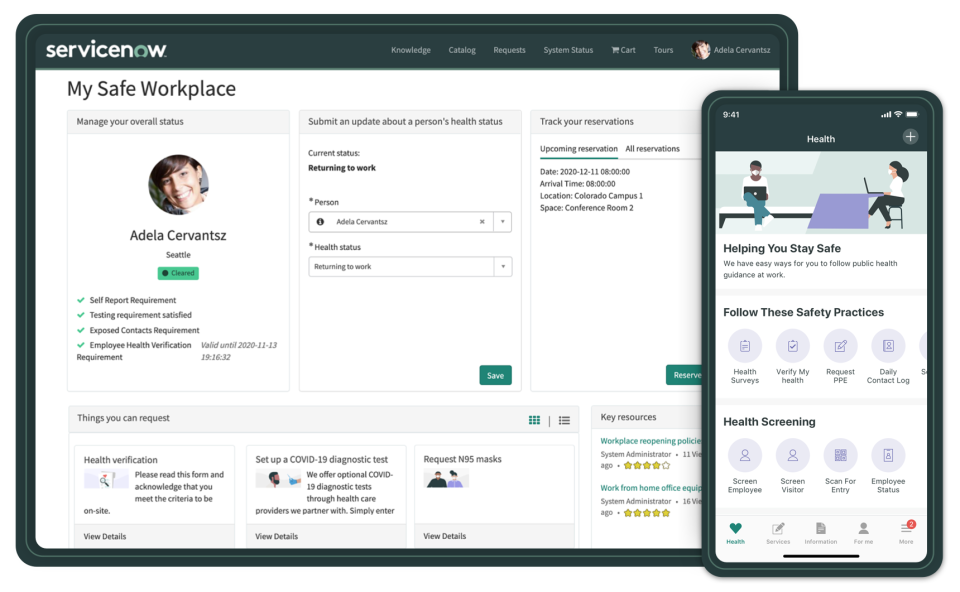How tech will help many of us readjusting back to the office post-COVID
Like many top executives, Jason Traff has lots on his mind to ensure his employees who want to go back to the office can safely.
The co-founder of Shipwell, an Austin, Texas-based cloud-based supply chain startup, Traff is considering letting a small number of workers back in the office a couple of days a week.
Although he's seen his business tripled and staff doubled by adding more remote employees by adapting a work-from-anywhere concept amid the COVID-19 pandemic, Traff and many of his employees miss the in-person collaboration and camaraderie. He's brainstorming how technology could both help create a productive and protective work environment.


Office making a comeback: COVID created a work-from-home culture but can the office become more appealing?
Some experts have already offered possible suggestions ranging from a slew of apps that help monitor contact tracing, operate touchless entries, to making sure there's proper ventilation flowing to knowing when meeting rooms and breakout spaces – even desks are available – and deep cleaned.
There's also using UV lighting that can help cleanse the air and smart windows featuring artificial intelligence and sensors that can help not only increase natural lighting but also hone air quality, temperature and sound.
"We've always been tech-forward as we're thinking about what that next phase of returning to the office is going to look like," Traff said. "I'm embracing these next steps both methodically, and cautiously."
As technologies of all sorts have helped us cope through the pandemic, many are slowly emerging out of their quarantine shells, and for some, that includes going back to the office. Big tech companies, including Facebook, Google, and Amazon – among the first to close its offices as COVID-19 surged – are planning to let employees return in reduced capacities. Microsoft and Uber have already allowed some workers back.
And the enterprise software company Salesforce just announced a three-stage approach to reopening its offices in the U.S. using its own work.com technology used to reopen its offices in Australia.
"An immersive workspace is no longer limited to a desk...the 9-to-5 workday is dead, and the employee experience is about more than ping-pong tables and snacks," Salesforce President and Chief People Officer Brent Hyder recently wrote in a company blog.
All of this raises an intriguing question: How can tech help us reengage to office life?
Upgrading the workplace
John Goulding, CEO of WorkVivo, an employee communications platform, said in this new hybrid environment making the digital-first office actually work is the biggest unsolved challenge facing leaders today.

"Tech will be at the heart of the once office-centric workplace and good communication will be key as companies make this transition," Goulding said. "Avoiding burnout from excessive amounts of transactional communication will help us connect on a more sincere and deeper level with our colleagues as we readjust to this new way of working.”
Tech can be a bridge if there's a willingness for companies to embrace tech in the same way they allowed employees to work remotely, said Cristina Banks, director of the Interdisciplinary Center for Healthy Workplaces at the University of California, Berkeley.
►What workers want: As COVID-19 wanes, employees want more from work, including child care and flexibility
►COVID-19 impact: Work from home more appealing than return to 'business as usual,' Harvard survey shows
Like many, Banks envisions a hybrid work culture that is paired in small, close-knit groups.
"There’s an opportunity for technology to provide a logistics model to identify the people who companies want back in the workplace and what days they want that same cluster back in the office consistently," Banks said.
Banks said she's been trying to get "a very talented entrepreneur" she declined to name to create a logistics algorithm, citing "we have to figure out what subset to use where they want to interact with each other."
However, one strategy is making sure there's enough open office space to have small group meetings, said Iain Urquhart, a senior vice president at Barco, a tech and workplace collaboration solutions company. This month, Barco let its employees back on a hybrid work schedule up to a 40% office capacity.
Before the pandemic, Barco debuted ClickShare Conference, a wireless conferencing system that works on all types of computers, smartphones and conferencing platforms, a complement to Zoom and other unified communications platforms.

Urquhart calls it "an adjusted normalcy," as his company works in a 50% capacity with one group coming in three days a week and another twice. And every room now has the capability of being a video conferencing room.
As for those who work remotely, some Barco employees are able to do virtual product demos by having video walls set up in their house or garage. "I think in our business it will be more role- and employee-dependent," Urquhart said.
Banks also believes that a balance of power between employers and workers will shift more toward employees who have proven they can be productive remotely. She said employees are returning to the office with more expectations from their bosses. This includes having a better sense of safety – both physically and mentally.
Banks thinks another tech that could help foster socialization in the office is having upgraded ventilation systems and UV lighting that can "kill pathogens to the air that's circulating is cleansed."
Are we ready to return to offices?
For nearly a year enterprise software company ServiceNow has offered companies Safe Workplace, a nine-app platform that tracks everything from contact tracing, social distancing floorplans, automated cleaning, and employee vaccination status.

"Going forward, companies constantly have to ask, 'Is the workforce ready? Is the workplace ready?' If they rush back too soon, they may lose a certain level of productivity," said Blake McConnell, ServiceNow, senior vice president of employee workflow products. "I think we're all on this learning journey."
Traff said he didn't believe in remote work before the pandemic. Now, he has hired employees working in more than 30 states as "the genie is out of the bottle" on how employees can choose where to work.
While he doesn't have a specific timetable on when his offices will reopen, Traff said he's talking to his landlord about office configurations as well as monitoring the nation's COVID-19 vaccination rates before making a final decision.
"Even when we go back to the office, the remote option is going to stay," Traff said. "If you want to be fully remote, you can; if you want to be back in the office, we will try to accommodate."
That will be the norm, said Rao Mulpuri, the chief executive officer at View, a company providing smart window technology to companies including Google and Facebook, and Netflix.

Employers are going to look at 'how do I get prepared in case something flares back up?'" Mulpuri said. "There’s a lot more people willing to invest in sensors, analytics, and density tracking."
Salesforce said it's taking such precautions upon its American workers returning, including tech-enabled touch-free handles and sensors, temperature screening stations, and air purifiers in conference rooms.
"This isn’t just the future of work, this is the next evolution of our culture," Hyder said. "We’re combining the strength of our values, our platform and our people to reimagine the way we work for the better – whether in person or in the cloud."
This article originally appeared on USA TODAY: Tech will be at the heart of the office-centric workplace post-COVID

 Yahoo Movies
Yahoo Movies 
